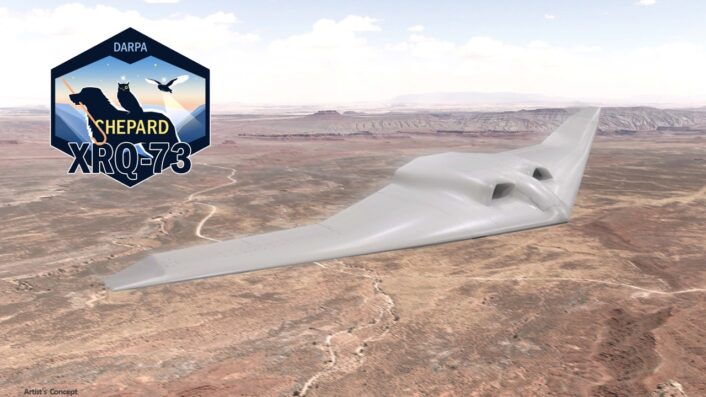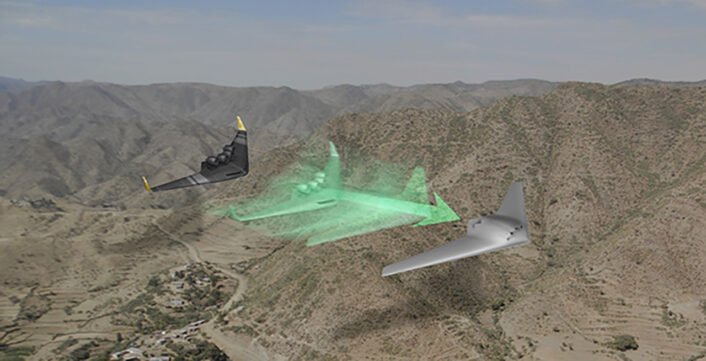The SHEPARD vehicle, recently designated the XRQ-73, represents a significant step forward in the evolution of unmanned aerial systems (UAS), leveraging hybrid electric propulsion technologies to enhance performance and operational capabilities.
On Jul. 10, 2024, Northrop Grumman unveiled the design and construction of the Series Hybrid Electric Propulsion Aircraft Demonstration (SHEPARD) vehicle. This uncrewed air system, developed for DARPA, has been officially designated as the XRQ-73 X-plane.
The aircraft in the image released by Northrop Grumman features a sleek, stealthy flying wing design. It has a low-profile fuselage with sharp, angular edges to enhance aerodynamic efficiency and stealth capabilities. The wings are broad and tapered with clipped wingtips, and there are two prominent air inlets located on the upper surface of the fuselage. Between these inlets is a fairing, likely housing critical systems or payloads.
The overall design suggests a focus on minimizing radar and visual signatures, emphasizing its role as an advanced, unmanned aircraft for surveillance and reconnaissance missions.
In fact, the XRQ-73 SHEPARD, built in collaboration with Scaled Composites (a subsidiary of Northrop Grumman), is part of DARPA’s “X-prime” program. It utilizes hybrid electric architecture and advanced component technologies to rapidly develop a new mission-specific aircraft design with unique propulsion architecture and power capabilities for the Department of Defense.

Program Overview
The XRQ-73 SHEPARD program is part of DARPA’s “X-prime” initiative, which focuses on rapidly maturing innovative technologies to meet urgent operational needs. The SHEPARD program draws on the technological advancements and lessons learned from the earlier Air Force Research Laboratory/Intelligence Advanced Research Projects Activity (AFRL/IARPA) Great Horned Owl (GHO) project, which produced the XRQ-72.

The GHO project aimed to create an ultra-quiet, high-efficiency reconnaissance UAS, and the XRQ-72 featured a series hybrid electric propulsion system with two electric generators powered by either gasoline or diesel. This system powered four ducted fans installed on the top of the fuselage, providing quiet and efficient operation.
The XRQ-72 had a wingspan of 30 feet, an overall length of 11.2 feet, and a height of 4 feet, with a weight of 300-400 pounds. The XRQ-73 is expected to be significantly larger, although exact dimensions are not yet known.
The goal of the SHEPARD program is to create a mission-focused, long-endurance aircraft capable of performing a variety of roles, including intelligence, surveillance, reconnaissance (ISR), and more.
Northrop Grumman is the prime contractor for the SHEPARD program, working closely with its subsidiary Scaled Composites and other key suppliers, including Cornerstone Research Group, Brayton Energy, PC Krause and Associates, and EaglePicher Technologies. The AFRL and the Office of Naval Research (ONR) are also contributing to the program, highlighting the collaborative effort to advance this groundbreaking technology.
Design and capabilities
The XRQ-73 is designed to be a Group 3 UAS, weighing approximately 1,250 pounds (567 kg). The aircraft features a stealthy flying wing design with tapered and clipped wingtips, two air inlets on the upper side of the fuselage, and a fairing between the inlets. This design is intended to minimize acoustic and visual detection, enhancing the UAS’s stealth capabilities.
The XRQ-73 SHEPARD employs a hybrid electric propulsion system, which builds on the series hybrid electric architecture used in the XRQ-72 and combines a fuel tank, gas turbine, electric generator, and battery in series to power an electric motor. This architecture provides several advantages, including quieter operation, fuel savings, and reduced emissions. These features make the XRQ-73 particularly well-suited for ISR missions, where stealth and endurance are critical.
Operational Goals
The SHEPARD program aims to quickly mature a new aircraft design that can be fielded within 20 months. The first flight of the XRQ-73 is expected by the end of 2024. This rapid development timeline reflects DARPA’s emphasis on agility and responsiveness in addressing emerging threats and operational needs.
As the SHEPARD program progresses, it has the potential to revolutionize the capabilities of unmanned aircraft in both military and civilian applications. The hybrid electric propulsion system offers a promising path forward for achieving longer endurance, quieter operation, and greater efficiency. By leveraging advanced technologies and a collaborative development approach, the XRQ-73 SHEPARD is poised to become a key asset for the Department of Defense and other stakeholders.

